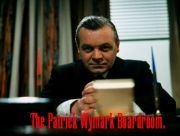
Blood On Satan's Claw
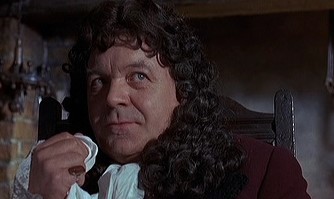
We have a 15 minute fireside chat with Dr Terror about this movie at this link
In Blood on Satan's Claw Patrick Wymark plays a 17th Century judge, who follows the classic horror film arc from disbeliever to challenger of the supernatural. In the wake of the success of Witchfinder General, Robert Wynne Simmons script (originally an Amicus-style Victorian anthology) was backdated to the late 1600's, with the three stories combined into one and filmed in April 1970 under the title, The Devil's Touch. Even though the film places Wymark in what would normally be the heroic role of the outsider who rids the community of evil, his performance is characteristically ambiguous and unpredictable. "I enjoy costume drama," Wymark told journalist Neville Nisse in June 1970, "and Cromwell and The Devil's Touch give me the chance to appease that urge". Sadly, Wymark would never see the final UK release in July 1971.
Blood on Satan's Claw opens with a young farmhand (Barry Andrews) uncovering the skeletal remains of something which seems neither fully beast nor man. The farm owner, Isobel Banham (Avice Landon) is disturbed by Andrews' notions and her visitor, the Judge (Wymark) agrees to put her mind at rest by investigating; but when Andrews leads him the place where he found the remains they have disappeared. That night, madness and mutilation shatters the peace of the farm. Soon afterwards Angel Blake (Linda Hayden) discovers another artefact, and incites her friends to play increasingly malevolent games.
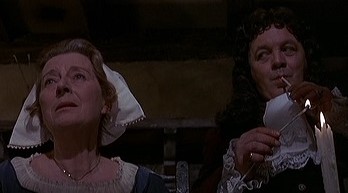
The Judge (Patrick Wymark) casts a secret look at Isobel Banham (Avice Landon)as she dictates the night's arrangements.
Wymark's character is only ever referred to as The Judge. Ironically, two years before Wymark had starred in the West End production of John Mortimer's The Judge (followed by a TV production in 1968). Mortimer's play dealt with a pitiless assize judge who returns to the town of his birth to uncover past wrong-doing. However, the naming of the character in the movie appears to have been coincidental, since Peter Cushing was Tigon's first choice for the role. Nevertheless, Wymark brings a similar ambiguity to the film character. We're never quite sure what he's up to.
Director Piers Haggard brings set dressing, costume and photography together to establish a rural authenticity from the opening minutes of the film. Wymark's character has equal credibility, complemented in the opening sequence by an abrasive performance from Avis Landon (who had played Vera Atkins, the real-life mission controller of Violet Szabo in Carve her Name With Pride ).
There is none of the fairy tale cosiness of Hammer Films in the settings. In common with Witchfinder General, the landcape of Blood on Satan's Claw is insecure. It appears to be set in the 1690's and whether through plague or conflict, the community appears to have been shattered. Landon shares her home with her nephew, (Simon Williams). There is no mention of her husband or his parents, although an attic room has been empty for many years (did someone die there?) While servant Charlotte Mitchell has children, she also has no husband. When Williams brings farmer's daughter Tamara Ustinov home, proposing to marry the girl the next day, his Aunt is appalled. Whether it's simple snobbery, or a deeper wish that Williams should replace what has been lost with a good and fruitful marriage is difficult to discern. The Aunt and the Judge appear to silently conspire to undermine the young girl's confidence during the evening. When Landon insists that Ustinov sleeps in the unused attic, Wymark casts a secretly approving look. Are they testing her? Do they both know (or hope that something bad will happen in the attic? Or is the Judge is just supporting Isobel's assertion of moral authority.
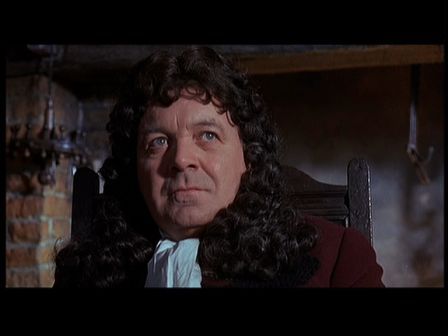
During the night, Ustinov wakes the house with hysterical screams. When Landon slaps the girl repeatedly as if punishing her, she retaliates by scratching Landon across the face. The Judge orders the attic nailed door shut until the morning when the men from "Bedlam" take Ustinov away (although London's Bethlem Hospital was popularly known as "Bedlam", the term had become popularly associated with madness during the Jacobean era, so it's likely that Wymark was referring to a local institution). Wymark comforts Williams, telling him that the now deranged girl, "could never have been a fit wife for you.", just before we see that her hand has sprouted a bear-like claw. The scratch apparently infects Landon's face. The last we see of her is her heavily bandaged face, suddenly sitting up in bed as if hearing a call. Just before she disappears from the house, Wymark realises that her pet bird is dead on the bottom its cage.
Although the Judge has displayed cruel and authoritarian characteristics, he reveals a softer edge, admitting to the nephew that he was once an "admirer" of Isobel's. He also proposes a toast "to his Catholic Majesty King James III. God bless him and keep him in exile." This indicates that the Judge is a Jacobite, who secretly believes that the Divine Right of Kings makes James the constituionally legitimate Monarch. The reign of the prince's father, James II was risky for the Judiciary, with 12 being dismissed in just three years, The fact that the Judge has managed to continue to survive and prosper within the new order of Protestant King William indicates a politically adept mind. The Judge is a man used to keeping secrets in a world where openly stating beliefs could literally become a matter of life or death.
The Judge also appears to regard the witch hunts of Matthew Hopkins as baseless persecution. When local physician (Howard Goorney) suggests witchcraft, the Judge snaps, "cleanse your mind of such fancies. Witchcraft is dead and discredited." But the physician then warns him that in the country, old beliefs die hard. He lends him a Necronomicon style tome which quickly convinces the Judge that some ancient evil is at work .
The ancient book* was introduced at the request of the producers, but does help to reinforce the Lovecraftian undertones of the previous scenes in the farmhouse. It's possible to view the evil as an alien spoor taking root and spreading throughout the community. "This parish is diseased," Wymark concludes. Before he returns to London on affairs of state, Wymark warns the Squire (James Hayter) that, "You must have patience. Even when people die. You must let it grow!Only then can the evil be destroyed." While this may seem cold-blooded and reckless, it also indicates that the Judge is determined to avoid hysterical scape-goating. He needs indisputable proof.
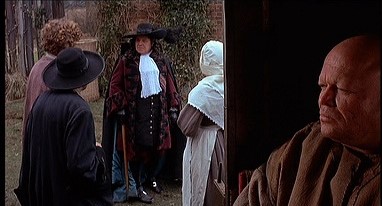
On his return, the madness has been spread by Angel Blake (Linda Hayden). She has gradually undermined the village community, making false accusations against the local priest (Anthony Ainley) and inspiring a cult of youthful murderers, gleefully assembling the body parts needed to bring the evil back to life. "It is more than witchcraft," Wymark declares, "I shall use undreamed of measures." Amusingly, those measures include a dog handler played by Milton Reid, who almost seems to be recreating his role as the human terrier used by Patrick Allen to hunt down the Scarecrow in Hammer's Captain Clegg.
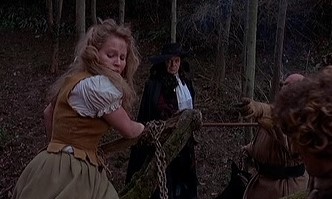
Michele Dotrice, hunted down by Patrick Wymark, Milton Reid and Barry Andrews
Reid helps Wymark track Michele Dotrice, who plays one of Angel's deceitful and defiant followers. There are several layers of irony in the scenes with Dotrice's character. Andrews rescues her after villagers have thrown her in the lake to test her as a witch. Although their methods are wrong, they are right to say that Dotrice's character believes herself to be a follower of Satan. Dotrice proves to be 'faithful', even though Angel Blake later believes she is a betrayer. There are overtones of The Crucible in the child-like capriciousness of Dotrice's character, and the scenes where Wymark's Judge threatens her with torture seem to contradict his earlier claims that witchcraft is discredited. "I do not wish to hurt you," Wymark tells her, holding a rapier to her face, "but I will have the truth." It's possible to view this scene as underlining the Judge's determination to distance himself from the likes of Matthew Hopkins. He needs proof that the supernatural is at work, and once Dotrice has told him where Angel's cult is gathering, he leaves her alone. "My master will be complete, " Dotrice taunts him, "You won't have no chance."
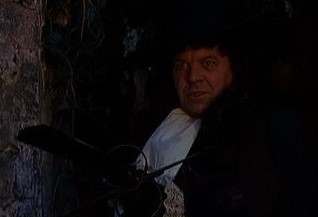
The climax sees the Judge confronting the patchwork construct which Angel Blake has assembled. The movie shifts into slow-motion ("a rhythmic break, to arrest the audience" according to Piers Haggard) as the Judge impales the creature with a massive sword. The film ends with a freeze frame of Wymark's face as the creature burns, his eye framed by the flames, matching the first shot of the creature's eye in its skull. Some have taken this to signify that the Judge himself has been possessed by the creature. It's an interesting view. The Judge has been antagonistic towards youth throughout the movie and the Demon is very much a childish construct put together of bits and pieces like a Guy Fawkes dummy. Has the Judge's strategy of "letting the evil grow" been a double-bluff. Does he destroy the "container" the children have put together for the Demon so that he can clear the way for a more fitting host? There would certainly seem to be enough evidence in the movie to support this view. But alternately, the appalled look on Wymark's face could suggest that he is still dealing with the realisation that the supernatural exists. For a man who has kept his beliefs guarded for self-advancement and self-preservation, he has finally put his life and his soul on the line to defeat evil.
* The miracle of DVD shows that the opening pages of the book come from a 1750 Swiss edition of a French commercial dictionary by Jacques Savary (Dictionnaire Universal de Commerce). The first illustration is very reminiscent of the creature from Curse of the Demon.
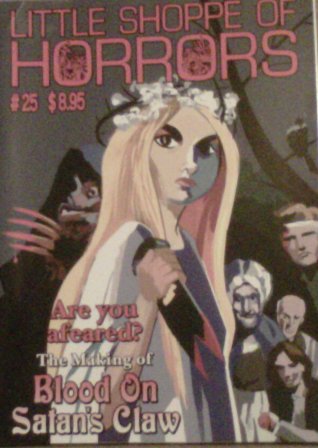 Blood on Satan's Claw is covered in depth in Little Shoppe of Horrors #25
Blood on Satan's Claw is covered in depth in Little Shoppe of Horrors #25